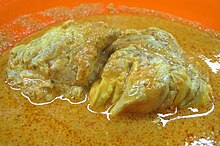Brain as food


The brain, like most other internal organs, or offal, can serve as nourishment. Brains used for nourishment include those of pigs, squirrels, horses, cattle, monkeys, chickens, fish and goats. In many cultures, different types of brain are considered a delicacy.
Cultural consumption
The brain of animals features in French cuisine, in dishes such as cervelle de veau and tête de veau. A dish called Maghaz is popular Muslim cuisine in Pakistan, Bangladesh, parts of India, and diaspora countries. In Turkish cuisine brain can be fried, baked, or consumed as a salad. In Chinese cuisine, brain is a delicacy in Chongqing or Sichuan cuisine, and it is often cooked in spicy hot pot or barbecued. In south part of China , pig brain is used for "Tianma Zhunao Tang". In South India Goat Brain Curry or Fry is a delicacy.
Similar delicacies from around the world include Mexican tacos de sesos.[1] The Anyang tribe of Cameroon practiced a tradition in which a new tribal chief would consume the brain of a hunted gorilla, while another senior member of the tribe would eat the heart.[2] Indonesian cuisine specialty in Minangkabau cuisine also served beef brain in a coconut-milk gravy named gulai otak (beef brain curry).[3][4] In Cuban cuisine, "brain fritters" are made by coating pieces of brain with bread crumbs and then frying them.[5]
Some archaeological evidence suggests that the mourning rituals of European Neanderthals also involved the consumption of the brain.[6]
Nutritional composition
DHA, an important omega-3 fatty acid which is also referred to by the technical designation of 22:6, is found concentrated in mammalian brains. For example, according to the nutrition data website, 3 oz. (85 g) of cooked beef brain contains 727 mg of DHA.[7] By way of comparison, the NIH has determined that small children need at least 150 mg of DHA per day, and pregnant and lactating women need at least 300 mg of DHA.[8]
The makeup of the brain is about 29% fat, most of which is located in myelin (which itself is 70–80% fat).[9] Specific fatty acid ratios will depend in part on the diet of the animal it is harvested from. The brain is also very high in cholesterol. For example, a single 140 g serving of "pork brains in milk gravy" can contain 3500 milligrams of cholesterol (1170% of the USRDA).[10]
Prions
Brain consumption can result in contracting fatal transmissible spongiform encephalopathies such as Variant Creutzfeldt–Jakob disease and other prion diseases in humans and mad cow disease in cattle.[11] Another prion disease called kuru has been traced to a funerary ritual among the Fore people of Papua New Guinea in which those close to the dead would eat the brain of the deceased to create a sense of immortality.[12]
Tanning
The brain can be useful to hunters: most animals have enough brain matter for use in the tanning of their own hides.[13][14][15]
See also
References
- ^ "Weird Foods: Mammal". Weird-Food.com. Archived from the original on 25 October 2005. Retrieved 14 October 2005.
{{cite web}}: Unknown parameter|deadurl=ignored (|url-status=suggested) (help) - ^ Meder, Angela. "Gorillas in African Culture and Medicine". Gorilla Journal. Archived from the original on 5 September 2005. Retrieved 14 October 2005.
{{cite web}}: Unknown parameter|deadurl=ignored (|url-status=suggested) (help) - ^ "Beef Brain Curry (Gulai Otak)". Melroseflowers.com. Retrieved 2013-12-07.
- ^ [1][dead link]
- ^ "Brain Fritters". Cubanfoodmarket.com. Retrieved 2013-12-07.
- ^ Connell, Evan S. (2001). The Aztec Treasure House. Counterpoint Press. ISBN 1-58243-162-0.
- ^ "Beef, variety meats and by-products, brain, cooked, simmered". Retrieved 2011-10-27.
- ^ "DHA/EPA and the Omega-3 Nutrition Gap / Recommended Intakes".
- ^ "Brain Facts and Figures". Retrieved 19 December 2010.
- ^ "Pork Brains in Milk Gravy". Retrieved 16 February 2011.
- ^ Collinge, John (2001). "Prion diseases of humans and animals: their causes and molecular basis". Annual Review of Neuroscience. 24: 519–50. doi:10.1146/annurev.neuro.24.1.519. PMID 11283320.
- ^ Collins, S; McLean CA; Masters CL (2001). "Gerstmann-Straussler-Scheinker syndrome,fatal familial insomnia, and kuru: a review of these less common human transmissible spongiform encephalopathies". Journal of Clinical Neuroscience. 8 (5): 387–97. doi:10.1054/jocn.2001.0919. PMID 11535002.
- ^ "The History of Brain Tan: page 1". Braintan.com. Retrieved 2013-12-07.
- ^ Mammals (2008-08-26). "Brain Tanning: Animal Planet". Animal.discovery.com. Retrieved 2013-12-07.[permanent dead link]
- ^ "Tanning Deer Hides and Small Fur Skins" (PDF). The Official Site of the Tennessee Government. Retrieved 2013-12-07.
